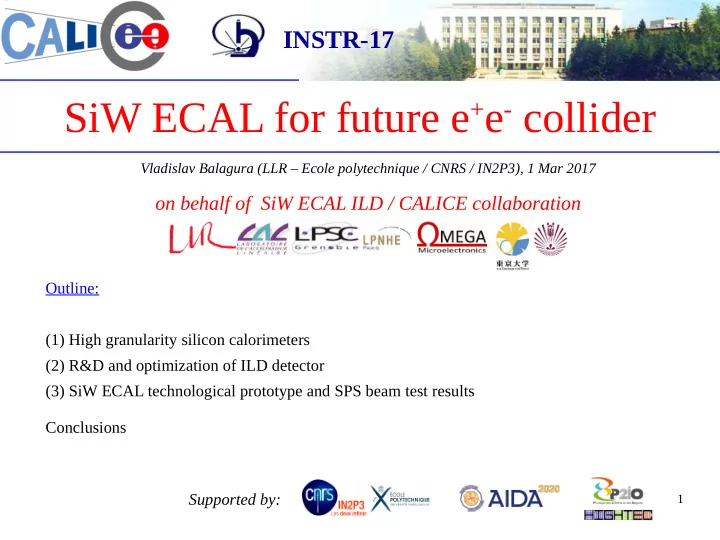

INSTR-17 SiW ECAL for future e + e - collider Vladislav Balagura (LLR – Ecole polytechnique / CNRS / IN2P3), 1 Mar 2017 on behalf of SiW ECAL ILD / CALICE collaboration Outline: (1) High granularity silicon calorimeters (2) R&D and optimization of ILD detector (3) SiW ECAL technological prototype and SPS beam test results Conclusions Supported by: 1
Silicon calorimeters ● easily segmentable, ● stable linear response (7000 e-holes /100 um/MIP), easy calibration, ● independent to environmental changes, stable in time ● radiation hard ● excellent timing (σ t ~20-50 psec) Ideal for PFA: lowest systematics, best granularity, but: ● high cost, ~ 2.5 EUR / cm 2 for mass production (offer from Hamamatsu in 2014) ● moderate sampling ECAL intrinsic resolution, though σ E ≤ 20%·√E is sufficient for PFA ● low-noise electronics required Detectors: (1) ECAL in future e + e - high-energy colider: ILD, SiD, CEPC, FCC, CLIC (2) Approved for CMS HGCAL phase II project: radiation hard 40 silicon layers in endcaps, 20 psec timing to reduce ≤ 200 pile-up (3) Proposed for ATLAS High Granularity Timing Detector (HGTD = preshower): 4 Si layers with low gain, fast to reduce pile-up https://twiki.cern.ch/twiki/bin/view/A tlasPublic/LArHGTDPublicPlots (4) Proposed for LHCb phase II ECAL upgrade, eg. 3 silicon layers, high granularity to measure angle btw pi0 photons, fast to reduce pile-up LHCB-LHCB-EOI-2017-001-002 2 Silicon sensors expand from trackers to calorimeters
International Large Detector (ILD) ECAL = modular octagonal barrel + 2 endcaps with “rings” Endcap ring Each module = carbon-fiber + W structure with alveoli where detector elements (slabs) slide in. Slab = Si sensor glued to PCB with electronics on both sides of W wrapped into carbon fiber. To avoid radial cracks: (1) trapezoidal shape is “inverted” (Videau structure”), (2) odd # barrel modules (3) minimal clearance between modules 1/8 of barrel ECAL options: 2012 ILD TDR baseline with 30 layers, 22 layers, 23% smaller radius 3
Separation of two close showers in ILD … determines PFA confusion for P(jet)>100 GeV. τ ± → Nγ Eur. Phys. J. C (2016) 76: 468. π-π JINST 6, P07005 (2011) Recent results on γ - γ (π) separation efficiency VS distance in ILD for PFA Garlic (only ECAL), Pandora and Arbor (both for jets). Both γ (π) should be reconstructed with E, position within ±20%, ±5 mm. γ-γ γ-π “Arbor Cheat” (yellow): two main clusters may be accompanied by (small E) clusters in AHCAL Garlic and Pandora: 2.5x2.5 mm 2 pixel is worse than default 5x5 mm 2 (!), artefact of optimization. 4 Comparison with CALICE physical prototype data will be available soon (note under review).
CALICE / ILD SiW ECAL SiW ECAL “physical” prototype (2005 – 2011), 18x18x20 cm 3 σ(E)/E = (16.6 ± 0.1)% / √E ☺(1.1 ± 0.1)% (MC: 17.3 / √E ☺ 0.5%) linearity within 1% but not embedded electronics, big power consumption NIM A608 (2009) 372 Carbon fiber – tungsten mechanical structure manufactured: 3/5 ILD module (5 years of R&D), max deviation from planarity 0.65 mm. Glue dots on 2d generation technological ECAL with embedded electronics (2011 – now): PCB (1) 18x18 cm 2 layer: ILD design channel density, 1024 pixels, 16 SKIROC chips, 4 sensors glued to PCB with 20 um precision; 10 layers produced (2) Power pulsed: readout switched OFF between “ILC trains” (~100 less power) (3) DAQ R&D ongoing, last beam test suffered from high noises, not finalized (4) Optimization of Si sensors, laser tests (5) Irradiation tests (50 ILC years Ok for Si) 5
Test beam with 3 layers (SPS, Nov’15) Typical beam spot Typical MIP and pedestal (2) Pedestal stable within ±1% ·MIP during 5 test days, except 2-3% ·MIP correction in one layer as f(stabilization time after power ON) (1) In 3072 channels: 2.2% masked. All layers power pulsed. Bunch crossing (BX) = 400 nsec. MIP / Pedestal RMS 3K ch. x 19 runs x 2 hours (3) Excellent MIP / Noise = 18 for optimal SKIROC settings (twice less for ILC) 6
Test beam with 3 layers (SPS Nov’15) Typical efficiency per chip in one layer MIP spread before calibration Efficiency = 98 – 99% , Raw data: ±6.4% spread between MIPs in channels except 2.9% of channels with sufficient μ ± statistics (83% out of ~3000) (dominated by 1 chip out of 48) Problems: (1) noise due to re-triggers = 1 usec “macro” event when almost every channel triggers once, (2) synchronization: signals in 2 layers may differ by one BX, (3) in shower, under high load chip trigger is delayed by one BX. 7
Conclusions (1) Silicon sensors for highly granular calorimetry, though expensive, are baseline option for many proposed detectors: ECAL for ILD, SiD, CEPC, FCC, CLIC, CMS HGCAL phase-2 upgrade of ECAL+HCAL endcaps for HL LHC (approved), ATLAS HGTD fast preshower, A few layers of LHCb ECAL in phase-II upgrade. Silicon sensors expand from trackers to calorimeters (if budget allows) (2) Analysis of PFA “confusion” in ILD: π – π separation JINST 6, P07005 (2011) separation of tau-decay photons Eur. Phys. J. C (2016) 76: 468. recent results: γ - γ and γ – π separation efficiency drops below ~3 cm distance, comparison with physical prototype data should appear soon as a CALICE note (3) After successful “physical” prototype, CALICE / ILD SiW ECAL group develops 2nd generation “technological” prototype: ILD design channel density is reached power pulsing successfully tested excellent MIP/Noise = 18, spread btw. pixel responses to MIPs before calibration = 6.4% efficiency = 98-99% still, much more work ahead. 8
Backup slides 9
Particle Flow Algorithms (PFA) ILD E(jet) measurement: ● charged tracks (65%) in tracker, ● photons (25%) in ECAL, ● neutral h (10%) in HCAL σ(E)/E = 3-4% for 35-500 GeV jets (~50% of traditional calo) eg. σ(M W,Z ) ~ Γ W,Z , sufficient to Si ECAL + Sc AHCAL distinguish W,Z statistically S.Green plot cited by D.Jeans at https://agenda.linearcollider.org/event/7014/contributions/ 34651/attachments/30224/45180/ild-caloOpt-talk.pdf 10
Recommend
More recommend